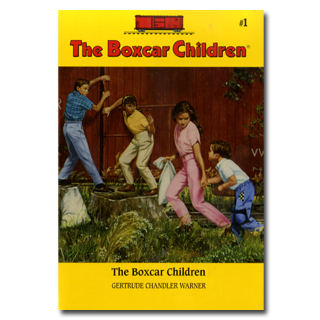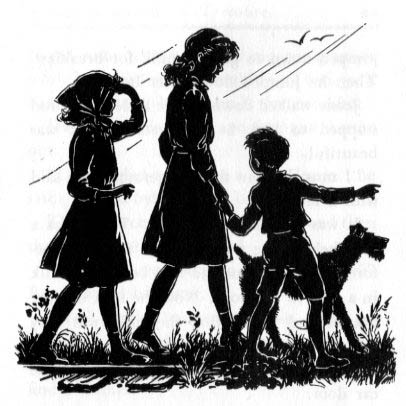
A FEW OTHER EVENTS FOR
APRIL 16:
- Happy birthday John Christopher (The White Mountains), Eleanora E. Tate (Celeste’s Harlem Renaissance), and Eva Moore (Buddy: The First Seeing Eye Dog).
- It’s the birth date of Garth Williams (1912-1996), Stuart Little, Charlotte’s Web, The Cricket in Times Square, the Little House series; Dorothy P. Lathrop (1891-1980), Hitty: Her First Hundred Years, Gunnel Beckman (1910-2003), Admission to the Feast, and Sir Kingsley Amis (1922-1995), We Are All Guilty.
- In 1963, Rev. Martin Luther King Jr. pens his famous letter from the Birmingham Jail. Read When the Children Marched: The Birmingham Civil Rights Movement by Robert H. Mayer and A Dream of Freedom: The Civil Rights Movement From 1954 to 1968 by Diane McWhorter.
Today we honor a writer who has inspired millions of children over the years to fantasize about living in a broken-down railroad boxcar. Born on April 16, 1890, in Putnam, Connecticut, Gertrude Chandler Warner lived across the street from the railroad station. Thirty freight trains might have passed by every day. Young Warner would talk to the men on the train and peek inside to see the neatly arranged living quarters. And she asked herself what it would be like to live in a caboose or a boxcar.
Due to poor health, Warner spent most of her schooling with a tutor and discovered that she loved to write. During World War I, although she did not have a high school diploma, she was recruited to teach—something that she continued for thirty-two years. While in the classroom, she began to work on a story inspired by her childhood fantasy. Putnam, a mill town, drew a diverse population, and many of her students struggled to learn English as a second language. She developed her tale to help these immigrant children and other slower readers. But she also worked to provide a fascinating story, one that would appeal to the better students in her class. The resulting book, The Boxcar Children, uses simple words and concepts, appeals to a wide range of readers in first and second grades, and contains a very compelling plot line.
In this totally satisfying book, the four Alden children—Henry, Jessie, Violet, and Benny—have become orphans and run away rather than be taken to their grandfather, who they do not know but fear. With only a few dollars in Henry’s pocket, the children locate an abandoned railroad boxcar and furnish it with pine branches and plates and cups from a nearby dump. Henry locates work that provides food and money, and they transform their surroundings into a kind a paradise, complete with a swimming hole for hot summer days. A spot behind a waterfall serves to keep butter and milk cold. In short, every small object the resourceful children find is made useful. In the end, their grandfather turns out to be kindly and takes them in, but he transfers the boxcar to his property so they can have more adventures.
Scott, Foresman & Company, a textbook publisher that sold books to schools, released Warner’s second version of the story in 1942. The silhouettes that adorn the book were no doubt inspired by Warner, who loved to give a silhouette portrait to each of her students. Albert Whitman & Company took over publication in the mid 1950s and made a paperback issue available in 1989. This led the way for a whole new generation of readers to fall in love with the Alden children—now more than 120 books exist in the series, graphic novels have been based on the books, and Patricia MacLachlan is currently writing a prequel to Warner’s original book.
Naturally, a few grown-ups protested about children living unsupervised. But this detail has never bothered children. In fact, it taps into a frequent childhood fear—what if children had to live without adults? Once a child reads The Boxcar Children, he or she never has to worry again. Readers love the self-reliance of this family and the way they work together for a happy ending.
If you are ever near Putnam, Connecticut, stop by and visit the Gertrude Warner Museum right near the railroad station. They won’t let you move into the boxcar —but you can see her home and the environment that inspired her books. Happy 121st birthday Mrs. Warner—you are still teaching children after all these years.
Here’s a passage from The Boxcar Children:
They all walked along through the woods, looking this way and that. After awhile the old track came out into the sun, and the explorers found that they were on top of a hill. They could look down and see the town below them.
“Henry is down there,” said Jessie.
Benny was walking along behind his two sisters.
Suddenly he cried happily, “Look, Jessie! There’s a treasure—a wheel!”
The girls looked where he was pointing, and they saw a big dump with many old bottles and tin cans on it. There were also both wheels and cups. Indeed, there were dishes of all kinds.
“Oh, Benny!” cried Jessie. “You saw the treasures first. What should we do without you!”
Originally posted April 16, 2011. Updated for .














I saw that this book was scheduled for today, and I waited until 12pm eastern (only 11pm here!) because I have such vivid memories of reading this book as a child. I couldn’t have been more than 8 or 9 when I read the first Boxcar Children book. I was the kind of little girl who was upset that Girl Scouts didn’t go camping or do the hnads-on things that the Boy Scouts got to do, so you can imagine how this book instantly captured me! The way that the four kids take care of themselves and become so incredibly resourceful was a dream come true for me; I fantasized about doing the same thing nearly every night! In fact, at that point in my life, I was really big into having “imaginary friends” (yes, I did still have imaginary friends even at 8-9 years old, haha). After reading this book (and the many others after it), Henry, Jessie, Violet, & Benny became my everyday imaginary companions. And with the book always within reach, that fantasy really wasn’t too far-fetched.
Thanks for the post. I always appreciate hearing from my Midnight readers. You identify two of the strengths of the book — the actions and solutions of the children seem possible for any reader. The children themselves could be people you would ordinarily meet.
I remember my 3rd grade class being enthralled with the BC being read aloud by teacher. I like the way you put it: “never has to worry again.” yes!
What a coincidence that I wrote this SLJ article about the Open Road Media version of the Boxcar Children this Thursday http://bit.ly/eBCICy
What a hilarious first sentence, Anita. I rarely admit this, but I have never read (or at least don’t remember reading) The Boxcar Children. Now I feel sad.
Chandler is also mentioned in today’s Writer’s Almanac!
Joyce and Rocco: She’s definitely on all of our minds. Leda: Simply as a writer, you should pick this up. Her sense of children is quite extraordinary.
I just picked this up for my 8yo yesterday. This isn’t a series I reread a million times as a child so I don’t remember much about it. Perhaps I’ll have to give it a try after my son is finished. : )
I loved The Boxcar Children SO much. I read many of the books, and was growing up when the series was being added to–ghost-written of course, oh the days of 90s packed series–so I had more to enjoy. Still, I’ve always had a special place for the first one. Benny and has teddy bear with a tail….
My brother was 11 years older than me so I was left with a backyard to play in all day long, all by myself. My day revolved between being a boxcar character or Laura of Little House. A very small wooden shack was my boxcar or log cabin. My play dishes were the ones they found in the dump. I can almost feel the warm summer wind as I WAS those characters. Anita, the first grade teachers were just asking me for books and I’m so excited. I did not know the wonderful history behind them. Again, you have made my day! Thank you.
Gertrude Chandler Warner captured my imagination when I was in elementary school many decades ago.
Her Boxcar Children stories are being checked out by a new generation of second and third graders in my school because their teachers read these stories when they were young girls.
I can’t keep these books on the shelves of my small school library, and I’m adding more copies with the few precious budget dollars I have left in order to meet the demands for more stories about Henry, Jessie, Violet, Benny, and faithful Watch.
Thanks for the link regarding more about GCW’s life. I’ll be sharing those wonderful tidbits with these classes next week!
One of my favorite series, The Boxcar Children is a wonderful, gentle story about the four Alden kids. I fear it gets lost among many of the wild fantasy/mystery/action/adventure stories popular now, but I remember selling several copies every week at the bookstore I worked at. The Boxcar Children is almost 90 years old, but it is clearly a timeless classic.
I used to own many books in this series, though the only one I can call to memory is this first one. I remember being so relieved that the grandfather was kind.
Oh, my childhood would have been so boring if it weren’t for The Boxcar Children. My sisters and I spent hours pretending we were them…we even made a “boxcar” out of stuff we found in the barn. The game never got old. This book truly shaped my life. I LOVE that my nephew is now reading it and is feeling the same way…truly timeless!
I remember falling in love with reading with a Boxcar Children books in my hands. They are so easy to tear through, and there is definitely a timeless fascination with a world without grownups that kids will always cling to. It’s scary, yes, but it’s also a welcome reprieve from the structure of every day kid life.
Thank you for honoring Gertrude Warner on the day of her birth, April 16, (1890). We, at the Boxcar Children Museum are inspired by her amazing imagination, her love of nature and her acts of kindness every day. It is amazing to hear all the comments from people who have been touched by her stories, including, in some families, three generations of readers. Please visit us at the museum if you are in the northwest corner of Ct–known as the quiet corner–and for a peek into the museum, visit our facebook page: Gertrude Chandler Warner Boxcar Children Museum.
Barbara: Thanks for your post. Many are excited to learn that a Museum has been set up in Ms. Warner’s honor.
I think, at one point in my childhood, I owned well over fifty Boxcar Children books. I loved the adventures the siblings went on, the mysteries they solved, and all the people they helped. But the first three books, and especially the very first one, were always my favorites. I do remember loving the first three because of the family aspects. It felt like the characters were discovering their own lives, and I loved that type of mystery most of all. I also picked up all sorts of useful tips in the first book… Jessie taught me how to cook baked potatoes in a campfire!
What a wonderful legacy Gertrude left for all of us. Lovely article, Anita!